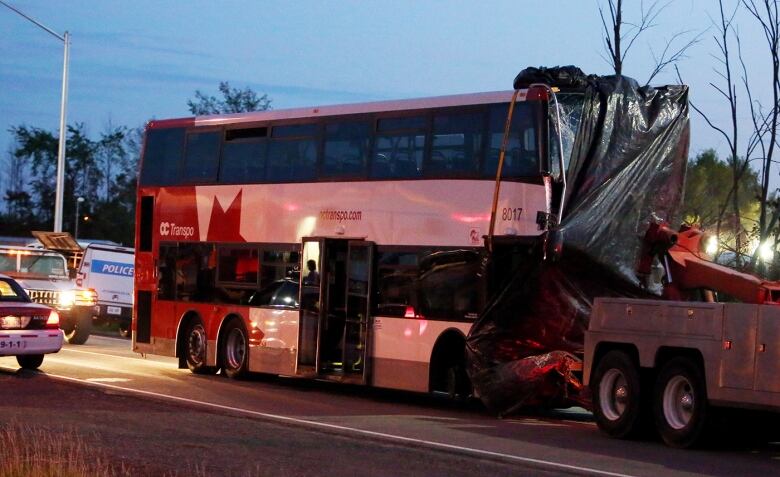TSB faces challenges collecting bus data in Ottawa bus-train crash
Update on investigation into bus-train crash expected Sept. 24
The Transportation Safety Board of Canada faceschallenges trying to retrieve all the necessary data from modules inside the OC Transpo bus involved in last year's fatal bus-train crash, says lead investigator Robert Johnston.
Investigators continue to examine the crash, which killed six people during morning rush hour on Sept. 18, 2013, with an update to the public coming next week.
- TIMELINE | Bus-train crash events on Sept. 18, 2013
- TIMELINE | Crash sparked level crossing questions in south Ottawa
A Via Rail train and OC Transpo bus collided at 8:48 a.m. ET in Barrhaven, a suburb in Ottawas south end, when the bus drove through the gate and struck the moving train.
The train and the rail crossing involved in the crash have been ruled out as causes. The TSB said the signal lights and gates were activated on time and the train was travelling far below the maximum allowable speed of 161 kilometres per hour.
The investigation has focused on data from the OC Transpo double decker bus, as well as the driver and factors like ergonomics, bus design, glare from the sun, visibility and possible distraction from the 82 passengers on board. That includes about 20 people who were standing on the bus.
TSB's first double decker investigation
The TSB had never before investigated a crash involving a double decker bus, according to former director of rail investigations Ian Naish, as it normally only investigates incidents in marine, pipeline, rail and air.
Since a Via Rail train was involved, the TSB enacted its mandate to lead the crash investigation.
- TSB to update public on bus-train crash next week
- Ottawa bus crash highlights lack of black box rules
Johnston said theTSBcommissioned a report to search for data that may have been lost.
"We are confident in the information that we do have,"Johnston said, adding OC Transpo mechanics and Cummins, the company that made the engine on the bus, helped locate other data in the presence of TSB investigators.
The bus has several data recorders including electronic monitors, a braking module and a GPS module, which are under the stairs at the front of the bus, to an engine control module located at the back of the bus.
There may have been damage to modules in the crash, as the front part of the bus was sheared off in the crash, but some of the most important data from the engine control module, which identifies any transmission issues, as well as speed and acceleration, has been downloaded.
"Youwon'thave all thedataif the event data recorders are destroyed," said Naish. "That means you can't interpret the information properly."
Double decker, Lac Mgantic caused delays
Naish said this investigation is quite complex due to the number of potential factors, including a bus not designed in North America.
There have also been delays due to the investigation into the Lac Mgantic train explosion, which was prioritized as the final act for now-former director Wendy Tadros.
The benchmark for the final report in a TSB investigation is typically one year, Naish added, but the final report is not yet ready.

"When I looked at an aerial map of that site, it was a very unusual alignment of the Transitway,"Naish said, "Its a very tight left-hand curve coming from that direction, and so the crossing signals are at the far end of that curve."
Ottawa police and the TSB have conducted parallel investigations on double decker buses and the Via Rail train featuring simulations and braking tests.
Bus driver David Woodard and five passengers Kyle Nash, Connor Boyd, Karen Krzyzewski, Michael Bleakney and Rob More died in the crash.
'Balance of probabilities'
Woodards death ultimately leaves more unanswered questions and has forced a stronger reliance on bus data, Naish said.
"There should be some record in the witness interviews of the hours of sleep, driver training, driver supervision. So, you can piece together pictures quite well, but its always going to be the balance of probabilities,"Naish said.

Ottawa police could only lay charges once the TSB has completed its investigation and finds any possible evidence of criminal negligence. Police would then take over and investigate further.
As for the City of Ottawa, it has already acted on early recommendations from the TSB, which includes cutting back shrubs near the crash site to increase visibility, installing new and larger signage to warn bus drivers about the train crossing and lowering the maximum speed from 60 km/h to 50 km/h on the Transitway.













_(720p).jpg)


 OFFICIAL HD MUSIC VIDEO.jpg)
.jpg)



























































































